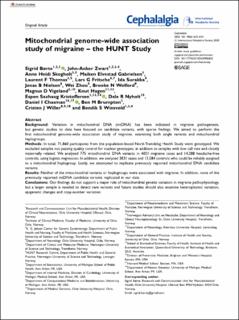| dc.contributor.author | Børte, Sigrid | |
| dc.contributor.author | Zwart, John-Anker | |
| dc.contributor.author | Skogholt, Anne Heidi | |
| dc.contributor.author | Gabrielsen, Maiken Elvestad | |
| dc.contributor.author | Thomas, Laurent | |
| dc.contributor.author | Fritsche, Lars G | |
| dc.contributor.author | Surakke, Ida | |
| dc.contributor.author | Nielsen, Jonas B. | |
| dc.contributor.author | Zhou, Wei | |
| dc.contributor.author | Wolford, Brooke | |
| dc.contributor.author | Vigeland, Magnus Dehli | |
| dc.contributor.author | Hagen, Knut | |
| dc.contributor.author | Kristoffersen, Espen Saxhaug | |
| dc.contributor.author | Nyholt, Dale R | |
| dc.contributor.author | Chasman, Daniel I | |
| dc.contributor.author | Brumpton, Ben Michael | |
| dc.contributor.author | Willer, Christen | |
| dc.contributor.author | Winsvold, Bendik K S | |
| dc.date.accessioned | 2020-09-29T08:11:04Z | |
| dc.date.available | 2020-09-29T08:11:04Z | |
| dc.date.created | 2020-02-18T13:32:09Z | |
| dc.date.issued | 2020 | |
| dc.identifier.citation | Cephalalgia. 2020, 40 (6), 625-634. | en_US |
| dc.identifier.issn | 0333-1024 | |
| dc.identifier.uri | https://hdl.handle.net/11250/2680147 | |
| dc.description.abstract | Background
Variation in mitochondrial DNA (mtDNA) has been indicated in migraine pathogenesis, but genetic studies to date have focused on candidate variants, with sparse findings. We aimed to perform the first mitochondrial genome-wide association study of migraine, examining both single variants and mitochondrial haplogroups.
Methods
In total, 71,860 participants from the population-based Nord-Trøndelag Health Study were genotyped. We excluded samples not passing quality control for nuclear genotypes, in addition to samples with low call rate and closely maternally related. We analysed 775 mitochondrial DNA variants in 4021 migraine cases and 14,288 headache-free controls, using logistic regression. In addition, we analysed 3831 cases and 13,584 controls who could be reliably assigned to a mitochondrial haplogroup. Lastly, we attempted to replicate previously reported mitochondrial DNA candidate variants.
Results
Neither of the mitochondrial variants or haplogroups were associated with migraine. In addition, none of the previously reported mtDNA candidate variants replicated in our data.
Conclusions
Our findings do not support a major role of mitochondrial genetic variation in migraine pathophysiology, but a larger sample is needed to detect rare variants and future studies should also examine heteroplasmic variation, epigenetic changes and copy-number variation. | en_US |
| dc.language.iso | eng | en_US |
| dc.publisher | SAGE Publishing | en_US |
| dc.rights | Navngivelse 4.0 Internasjonal | * |
| dc.rights.uri | http://creativecommons.org/licenses/by/4.0/deed.no | * |
| dc.title | Mitochondrial genome-wide association study of migraine – the HUNT Study | en_US |
| dc.type | Peer reviewed | en_US |
| dc.type | Journal article | en_US |
| dc.description.version | publishedVersion | en_US |
| dc.source.pagenumber | 625-634 | en_US |
| dc.source.volume | 40 | en_US |
| dc.source.journal | Cephalalgia | en_US |
| dc.source.issue | 6 | en_US |
| dc.identifier.doi | 10.1177/0333102420906835 | |
| dc.identifier.cristin | 1795325 | |
| dc.description.localcode | Open Access CC-BY | en_US |
| cristin.ispublished | true | |
| cristin.fulltext | original | |
| cristin.qualitycode | 1 | |

